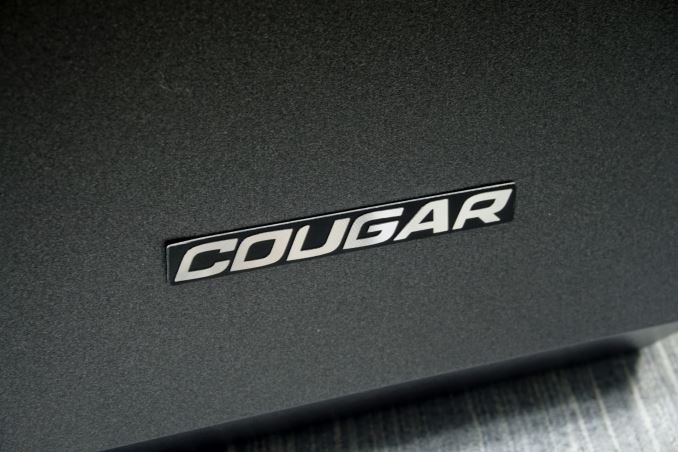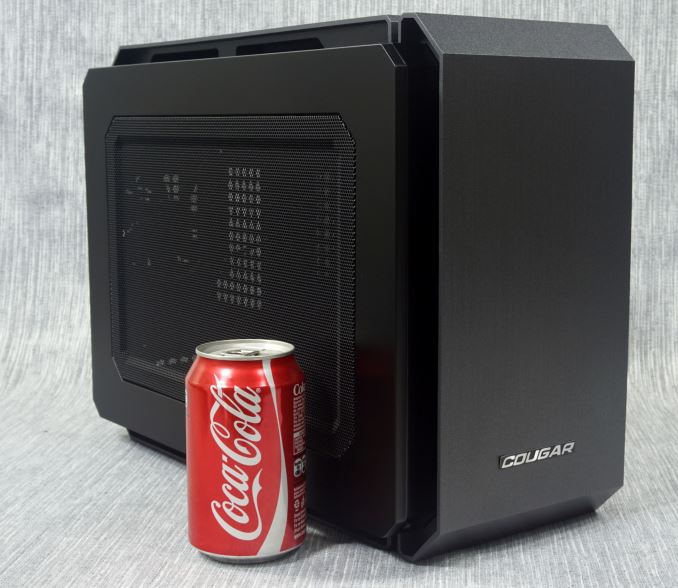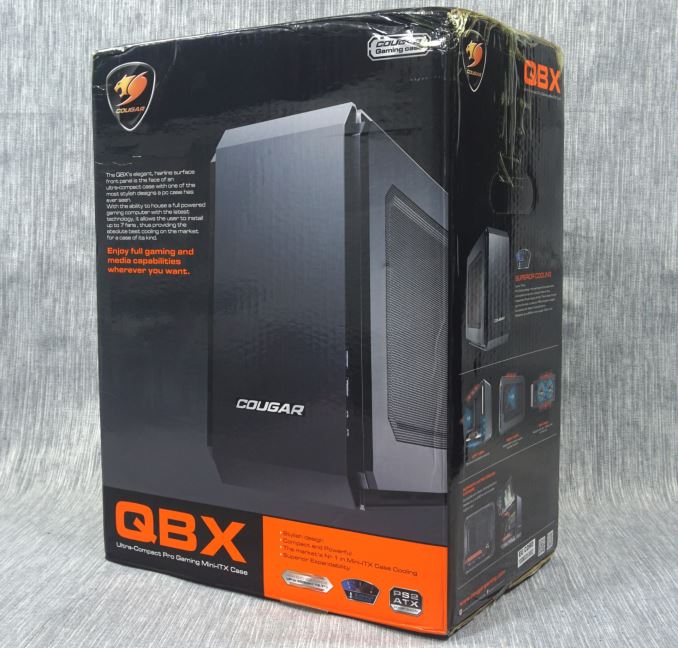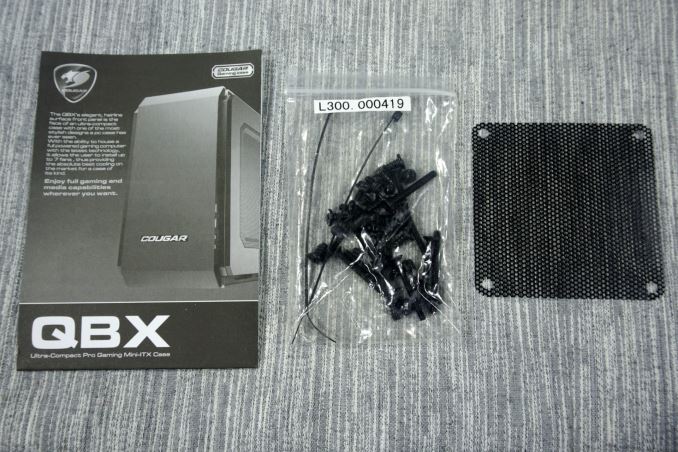The Cougar QBX Mini ITX Case Review
by E. Fylladitakis on November 13, 2015 8:00 AM EST- Posted in
- Cases/Cooling/PSUs
- Mini ITX
- Cougar
- Case

Cougar originates from Germany and originally specialized in advanced computer peripherals. During the past few months we have looked at several of their high end peripherals and mice. The company however produces more than just keyboards and mice, having diversified towards PC power supply units and cases. Cougar however is not particularly well-known for their cases, even though they have nearly a dozen designs available. One of their most recent releases is the their first Mini-ITX case, the QBX, which was unveiled at Computex and even won a design & innovation show award in the process. This is the case that we will be reviewing today.
Cougar's marketing is making some very bold claims regarding the performance and capabilities of the QBX. "Powerful Graphics". "Massive Storage". "The Best Cooling of Its Class". And then we notice a $53 price tag, which makes everything sounding a little bit too good to be true. So today we are putting the QBX to the test to see for ourselves where the new case excels and where it falls short.
11.2 oz Coke can for size comparison
| Cougar QBX | ||
| Motherboard Size | Mini-ITX | |
| Drive Bays | External | One slim ODD (slot-loading only) |
| Internal | 1 × 3.5" 4 × 2.5" |
|
| Cooling | Front | 80 mm (optional) |
| Rear | 92 mm (included) | |
| Top | 2 x 120 mm (optional) | |
| Sides | 120 mm (optional) | |
| Bottom | 2 x 120 mm (optional) | |
| Radiator Support | Front | - |
| Rear | - | |
| Top | - | |
| Sides | Up to 240 mm (only one 120 mm fan) | |
| Bottom | - | |
| I/O Port | 2× USB 3.0, 0× USB 2.0, 1× Headphone, 1× Mic | |
| Power Supply Size | ATX | |
| Clearances | HSF | 105 mm |
| PSU | 140 mm | |
| GPU | 350 mm | |
| Dimensions | 291 mm × 178 mm × 384 mm 11.46 in × 7.01 in × 15.12 in |
|
| Prominent Features | · Expandible: Powerful Graphics · Expandible : Massive Storage + ODD · The Best Cooling of Its Class |
|
| Price | $53 incl. shipping | |
Packaging & Bundle
Cougar supplies the QBX in a relatively small (but tall) box that hints the proportions of the case. The artwork of the box follows the orange/black color theme of the company and is mostly based on pictures of the case itself. The main features of the case are clearly printed on the sides of the box. Inside the box, the lightweight case is well protected with Styrofoam and wrapped inside a nylon bag.
The bundle supplied with the QBX is very basic, which was not unexpected considering the retail price of the case. Inside the small cardboard box we found only a very basic leaflet with installation schematics, black screws and mounting hardware, two small cable ties and one nylon filter for a 80 mm fan.













42 Comments
View All Comments
Ninhalem - Friday, November 13, 2015 - link
With a smaller PSU and custom sleeved cables, a competent water cooling modder could put a decent system together inside this case.Samus - Friday, November 13, 2015 - link
I was thinking the same thing. If you put an SFX PSU in there with an ATX adapter plate you'd have a ton of extra room for cables, hoses, a reservoir, longer graphics card, etc. Silverstone almost exclusively uses SFX PSU's in their ITX systems just for the reason they save so much space.Refuge - Friday, November 13, 2015 - link
Yea but if they were trying to keep costs down (Which I like the price personally) then an SFX PSU wouldn't have been helpful.They are fantastic, but more expensive than comparable ATX PSU's. Besides as you pointed out, it is still an option for the builder who wants to invest that extra scratch.
zeeBomb - Friday, November 13, 2015 - link
Oh this cougar...cable game strong!I got one question... What ATX cases in todays market has pretty good cable management and well recognized by PC enthusiasts? I've been eyeing Fractal design cases...but your help is really need!
Samus - Friday, November 13, 2015 - link
Really, the best cable management is in OEM systems, because they custom make the PSU's (no ridiculous 24+4 or 24+8 pin connectors) but that limits your motherboard compatibility, and therefor your overclocking capabilities.The only way to get decent cable management with a custom build is to use a modular PSU, and a high end case like Lian-Li, Silverstone and Corsair
I'm personally a big fan of the Silverstone FT03-Mini and Corsair Obsidian 250D for ITX platforms. For ATX, check out the Corsair 450D. For the price, its a really good, professional-looking case.
I avoid Fractal and NZXT like the plague. They are really just crappy quality. They completely ignore obvious design choices in every model...there's always one thing that utterly ruins the case, requiring some extreme modding and wasted time to work around.
The original Silverstone Fortress FT01 had probably the best cable management of any case I've ever owned, but it is a dated design (2008) although Silverstone has done a remarkable job supporting it. You can buy a new front IO backplane that has USB 3.0 ports for $20, and they have SATA and SAS backplanes for each hotswap bay available, eliminating cables completely.
zeeBomb - Friday, November 13, 2015 - link
Wow very informative answer, tyvm!!! I was checking out the Fractal Design R5 case as it did fare well on my checklist, but your recommendations opens up a whole new list. Thanks a ton Samus!quest_for_silence - Monday, November 16, 2015 - link
Unfortunately those negative comments were mostly groundless/rather questionableBurntMyBacon - Monday, November 16, 2015 - link
@quest_for_silence "Unfortunately those negative comments were mostly groundless/rather questionable"I'll agree that they weren't well defined. However, I don't think the comments were entirely baseless. My personal experience is that the four NZXT systems I've built into have plastic fronts that scratch up quickly and easily. The structures also had far more flex than I like, though the customers were clearly more concerned with the aesthetic marring on the front. For reference, these were the Phantom 410, Phantom 630, Guardian 921, and the very recent Noctis 450.
I've only worked with the Fractal Design Define R4 and R5, so I can't comment on their other products. As far as these go, I've had decent luck. They don't really scratch up any worse than their competitors and the noise dampening is solid. The structure has a little more flex than I'd like, but generally isn't bad.
However, it is hard for me to recommend one of these Fractal Design cases if you can get your hands on a Nanoxia Deep Silence case. On the more expensive end, the high end Silverstone and Lian Li cases have some of the best build quality I've seen. The Silverstone Fortress FT02/Raven RV02 were some of the best cases I've ever built into. CaseLabs is probably the best, but Dat price. Only ever got to build into one of these and still dream of the day I can afford one for my own system. Corsair's offerings range from solid value with decent build quality (Carbide series) to high end case with a price that matches (Obsidian series). They also happen to be some of the easiest cases I've had the privilege of building into.
BurntMyBacon - Monday, November 16, 2015 - link
@zeeBombIf you are considering a Fractal Design Define R5 case, you may want to look into Nanoxia's Deep Silence series cases. Much higher build quality IMHO.
BurntMyBacon - Monday, November 16, 2015 - link
@SamusI generally agree with the above. I've had decent luck with Fractal Design, but I've only built into a Define R4 and R5. That said, like you, I find that there are better options out there. I would only add one manufacturer to your list: Nanoxia for noise dampening cases. Build quality is much higher than the Fractal Design cases IMHO. Cable management is only adequate, but I'd be remiss not to mention them for build quality, especially if you are looking for noise dampening. They don't have much in the way of mini-ITX, though. Sorry CaseLabs. You make some of the best cases out there, but $500 is a bit much.